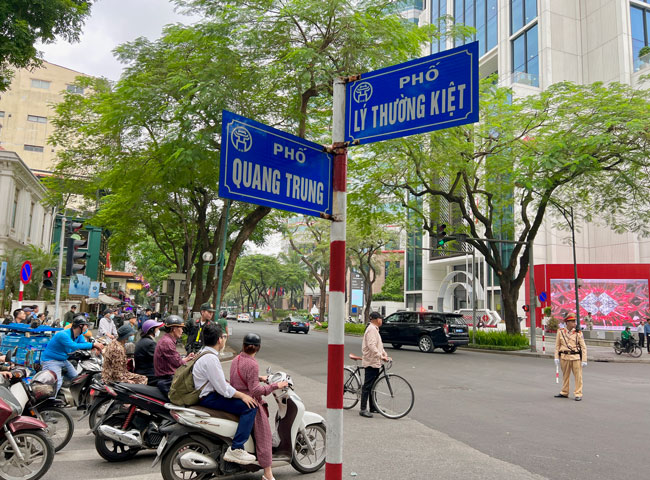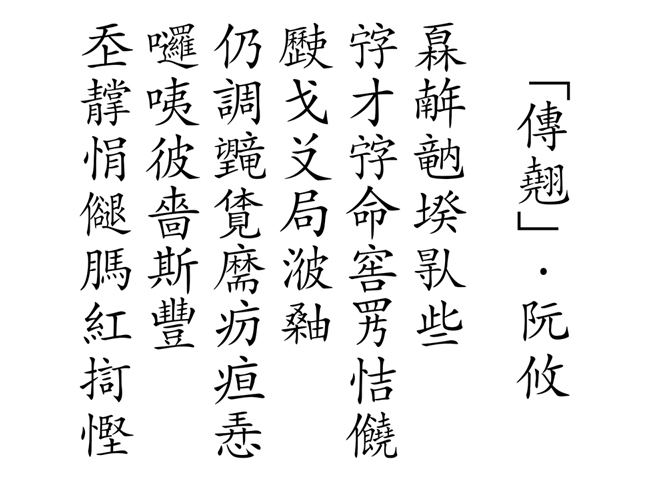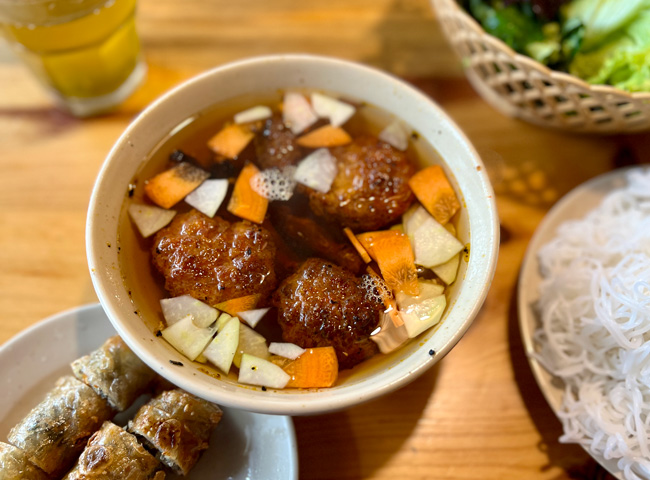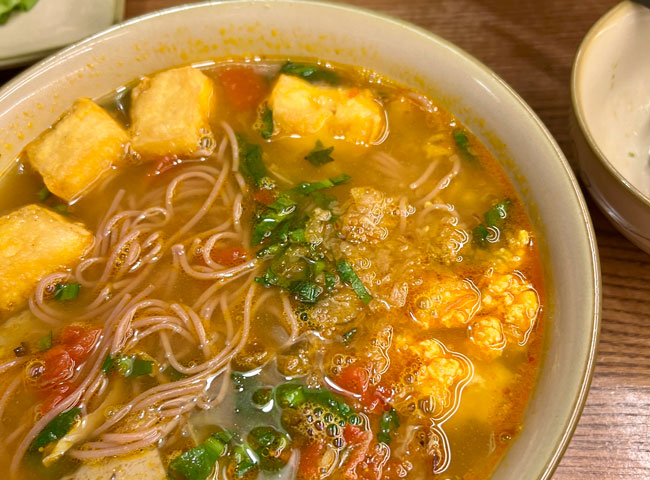On our food walking tours, the most famous Vietnamese soup, phở, often confuses our clients with the word “Phố” (street). We also received questions related to our language, like “why does written Vietnamese look like English?”. Hence, the post will provide a brief history and glimpse of Vietnamese alphabet.

A Brief History of Vietnamese Alphabet
The history of Vietnam dates back to the Stone Age, when its first state was established in 2879BC. Along the history of the country, Vietnamese people still speak Vietnamese like we do now. The language is today the mother tongue of 86% of the total population, and is the second language of the 53 ethnic minorities living in Vietnam.
Until 17th century, it’s unclear whether we had our own writing system or not. But due to 1,000 years of Chinese domination, Vietnamese dynasties all used Chinese characters in official documents. Therefore, classical Chinese characters are found in temples and pagodas today.
Around 13th century, some Vietnamese intellectuals “invented” the Vietnamese characters, called chữ Nôm (example at the end of the post), by borrowing Chinese characters. But, to be able to learn chữ Nôm, one must know and be good at Chinese characters. Hence, chữ Nôm was not widely disseminated.
In 1617, Francesco de Pina, a Portuguese Jesuit missionary, arrived in central Vietnam. He was the first person latinizing Vietnamese using the Latin alphabet and diacritics from the Italian, Greek, and Portuguese to transcribe the Vietnamese language, so his followers could read Christian scriptures. By that, he created the Vietnamese alphabet.
In 1651, based on the documents of his predecessors, Alexandre de Rhodes – a French missionary, printed Vietnamese – Portuguese – Latin Dictionary in Rome. In the following years, Vietnamese alphabet was used among churches and Catholic parishes in Vietnam.
From 1862 when Vietnam became a French colony, the Latin Vietnamese alphabet, Chinese character, and ‘chữ Nôm’ were used alongside each other. But, to widely disseminate the Vietnamese alphabet, the French colonials eliminated the study of Chinese characters in Vietnamin 1919.
Since then, the modern Vietnamese alphabet has become popular in Vietnam, and became the country’s official script in 1945. Gradually, Vietnamese people became “illiterate” with Chinese and Nom scripts.
The 29 Letters of the Vietnamese Alphabet
The Vietnamese alphabet, chữ Quốc ngữ in Vietnamese, uses most of the letters of the 26letters in English alphabet – except for F, J, W, and Z (which are only found in loanwords).
Comparing to the English alphabet, Vietnamese alphabet has 7 variant letters: Ă, Â, Đ, Ê, Ô, Ơ, and Ư, which are vowel makers to distinguish different vowel sounds. That makes the Vietnamese alphabet 29 letters:
A-Ă-Â-B-C-D-Đ-E-Ê-G-H-I-K-L-M-N-O-Ô-Ơ-P-Q-R-S-T-U-Ư-V-X-Y.
The Vietnamese’s Tone Marks
Besides those 7 vowel makers, Vietnamese alphabet has been added with some new features to accurately show Vietnamese pronunciations. Here are the features:
1. Based on the 29 letters, 6 tone marks are also added. Except the level tone which is not marked, the other five tones are indicated by diacritics applied to the vowel of the syllables. The table below shows the tone marks and marked vowels in Vietnamese.
|
Tone marks |
Marked vowels |
|||||||||||
|
Dấu ngang (Unmarked) |
A |
Ă |
 |
E |
Ê |
I |
O |
Ô |
Ơ |
U |
Ư |
Y |
|
Dấu huyền (Grave) |
À |
Ằ |
Ầ |
È |
Ề |
Ì |
Ò |
Ồ |
Ờ |
Ù |
Ừ |
Ỳ |
|
Dấu hỏi (Hook above) |
Ả |
Ẳ |
Ẩ |
Ẻ |
Ể |
Ỉ |
Ỏ |
Ổ |
Ở |
Ủ |
Ử |
Ỷ |
|
Dấu ngã (Tilde) |
à |
Ẵ |
Ẫ |
Ẽ |
Ễ |
Ĩ |
Õ |
Ỗ |
Ỡ |
Ũ |
Ữ |
Ỹ |
|
Dấu sắc (Acute) |
Á |
Ắ |
Ấ |
É |
Ế |
Í |
Ó |
Ố |
Ớ |
Ú |
Ứ |
Ý |
|
Dấu nặng (Dot below) |
Ạ |
Ặ |
Ậ |
Ẹ |
Ệ |
Ị |
Ọ |
Ộ |
Ợ |
Ụ |
Ự |
Ỵ |
2. There are these 12 single vowels in Vietnamese: A, Ă, Â, E, Ê, I, O, Ô, Ơ, U, Ư, Y.
3. In addition to those 12 single vowels, there are these 32 diphthongs and 13 triphthongs in Vietnamese:
- 32 diphthongs: AI, AO, AU, ÂU, AY, ÂY, EO, ÊU, IA, IÊ/YÊ, IU, OA, OĂ, OE, OI, ÔI, ƠI, OO, ÔÔ, UA, UĂ, UÂ, ƯA, UÊ, UI, ƯI, UO, UÔ, UƠ, ƯƠ, ƯU, UY.
- 13 triphthongs: IÊU/YÊU, OAI, OAO, OAY, OEO, UAO, UÂY, UÔI, ƯƠI, ƯƠU, UYA, UYÊ, UYU.
4. To combine with vowels to form a complete word, there are also 17 single consonantletters and 11 compound consonats (10 double-letters and 1 one triple-letter). When combining with vowels, consonants generally stand in front or behind vowels.
- The 17 single consonants: B, C, D, Đ, G, H, K, L, M, N, P, Q, R, S, T, V, X
- The 10 consonant digraphs, 1 trigraph: CH, GH, GI, KH, NH, NG, PH, TH, TR, QU, NGH
- There are 8 final consonants, and 2 final semi-vowels: C, CH, M, N, NH, NG, P, T (in which, the final consonants NH, CH never come after the vowels U, Ô, O).
Those are the tone rules for vowels with different sounds. It’s like music, where only the correct sound can come from the instrument. It doesn’t matter which instrument, as long as the sound follows the rules.
Structure of Vietnamese Alphabet
As a result of influence from the Chinese writing system, each syllable in Vietnamese is written separately as if it was a word. A written syllable consists of at most three parts, in the following order from left to right:
- An optional beginning consonant.
- A required vowel and tone mark (if needed) applied above or below it.
- An ending consonant, can only be one of the following: C, CH, M, N, NG, NH, P, T, or nothing.
Example 1: Xin chào! Bạn có khoẻ không? (Hello! How are you?).
Example 2: Following is an excerpt of Truyện Kiều (The Tale of Kiều), an epic poem in Vietnamese written by Nguyễn Du (1765–1820), which is considered the most famous poem and a classic work of Vietnamese literature. These first six lines in the prologue of Truyện Kiều, in original text, was written in Vietnamese using the chữ Nôm.

Below are those 6 lines written in modern Vietnamese alphabet and its translation in English.
“Trăm năm trong cõi người ta,
Long time in human life,
Chữ tài chữ mệnh khéo là ghét nhau.
Fate is so bad for nice people.
Trải qua một cuộc bể dâu,
Go through such difficult,
Những điều trông thấy mà đau đớn lòng.
I saw and had struggle feelings.
Lạ gì bỉ sắc tư phong,
One’s full, others’ lacking,
Trời xanh quen thói má hồng đánh ghen.
Heaven, it keeps hating beauty.”
Example 3: A paragraph of literature, troducing Vietnam and its people, in Vietnamese alphabet and English.
“Việt Nam là đất nước yên bình có rất nhiều cảnh đẹp với biển cả bao la, núi non hùng vĩ, đồng lúa chín mênh mông, với nhiều truyền thống văn hóa lâu đời. Trong chiến đấu, Việt Nam có rất nhiều anh hùng dũng cảm, tài ba đứng lên bảo vệ quê hương khi có kẻ thù xâm lăng. Trong sản xuất, người Việt Nam luôn lao động cần cù, chăm chỉ, khéo léo, thân thiện, và sáng tạo.”
“Vietnam is a peaceful country owning many beautiful landscapes with vast seas, majestic mountains, vast rice fields, and many long-standing cultural traditions. In combat, Vietnam has many brave and talented heroes, who stood up to protect their homeland when an enemy invaded. In production, Vietnamese people are always diligent, hard-working, skillful, friendly, and creative.”





